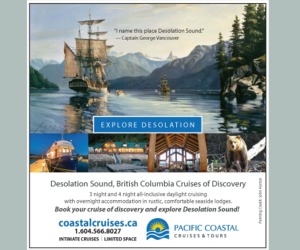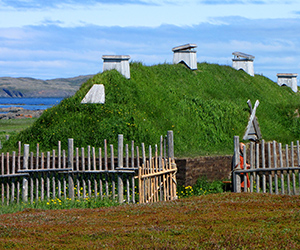CANADA HISTORY
L-Anse Aux Meadows

The discovery and excavation of the Viking settlement at L'Anse aux Meadows in Newfoundland stand as one of the most significant archaeological findings in Canadian history, validating the age-old Viking sagas and proving that Norse explorers, led by Leif Erikson, were the first Europeans to set foot in North America around the year 1000 AD. The idea that the Vikings had established a toehold in the Americas had long been speculated, thanks to the sagas passed down through generations in Iceland and Norway, but it wasn't until the 20th century that these stories were confirmed with concrete evidence. The settlement at L'Anse aux Meadows forever changed the narrative of European exploration in the New World, placing the Vikings nearly 500 years ahead of Columbus.
For centuries, the Viking sagas—particularly the Saga of the Greenlanders and the Saga of Erik the Red—recounted tales of Norse explorers venturing westward from Greenland to a land they called Vinland. This Vinland was described as a lush, bountiful place, rich in resources that would have been invaluable to the Norse settlers. The sagas spoke of vast forests that could provide timber for building ships and shelters, fertile land with wild wheat and grapes, abundant game in the form of moose, deer, and beaver, and rivers teeming with salmon and other fish. These details suggested that somewhere along the Atlantic coast of North America, the Vikings had made contact with a new, fertile land—an area vastly different from the harsh climates of Greenland and Iceland.
Despite the richness of these accounts, for many years, the location of Vinland remained a mystery, and the sagas themselves were often regarded as a blend of historical fact and myth. However, the breakthrough came in the early 20th century when a Newfoundland historian named William A. Munn published a theory based on these sagas. Much like Heinrich Schliemann had used Homer's Iliad to uncover the ancient city of Troy, Munn meticulously analyzed the details of the sagas to hypothesize the location of the Viking settlement. He concluded that Leif Erikson’s Vinland was likely located at or near Pistolet Bay, on the northern tip of Newfoundland.
Munn’s work, however, was more theoretical than empirical, and it would take another half-century before the real breakthrough came. In the 1960s, a Norwegian explorer and archaeologist named Helge Ingstad, along with his wife Anne Stine Ingstad, a trained archaeologist, took up the challenge of verifying Munn’s claims. Ingstad, like Munn, believed that the sagas held clues that could lead to the discovery of a Viking settlement in North America. After years of surveying the northeastern coasts of the United States and Canada, Ingstad zeroed in on northern Newfoundland as the most likely location of Vinland.
In 1960, Helge Ingstad arrived at L'Anse aux Meadows, a site on the northern tip of Newfoundland that fit many of the descriptions from the sagas. With the help of local residents who had long suspected the presence of something significant beneath the land, Ingstad began a careful survey of the area. What he found would confirm what historians and archaeologists had long suspected—L'Anse aux Meadows was the site of the first European settlement in the New World.
The excavation at L'Anse aux Meadows began in earnest in 1961, led by Helge and Anne Stine Ingstad. Over the next several years, they unearthed the remains of a Norse settlement, including the foundations of eight buildings constructed in the distinctive style of Viking longhouses. These structures were made of sod-covered timber, a method typical of Viking settlements in Iceland and Greenland. The site also contained evidence of iron smelting, carpentry, and ship repair, suggesting that the settlement was not merely a temporary camp but a fully functioning base of operations for the Norse explorers.
The discovery of ironworking at the site was particularly significant, as it indicated that the Vikings had brought their advanced technology to the New World. The remains of a forge and slag from smelted iron demonstrated that the settlers were able to extract and work metal, a skill that would have been crucial for maintaining their tools and weapons in the harsh environment of Newfoundland. This level of sophistication distinguished the Vikings from the Indigenous peoples they encountered and underscored the importance of L'Anse aux Meadows as a strategic base for further exploration.
The archaeological evidence found at L'Anse aux Meadows—combined with the historical accounts from the sagas—painted a vivid picture of Viking life in North America. The settlement was likely occupied for only a short period, perhaps no more than a few years, and served as a seasonal base for exploring the surrounding areas. The Vikings may have ventured further south, possibly into the Gulf of St. Lawrence or even down the Atlantic coast of North America, as suggested by the sagas’ descriptions of fertile lands and grapes.
One of the enduring mysteries of L'Anse aux Meadows is why the Vikings abandoned the settlement after such a short time. The sagas suggest that conflicts with the Indigenous peoples, whom the Vikings referred to as Skrælings, may have played a role. The Norsemen likely had hostile encounters with the local Indigenous groups, and despite their technological advantages, the small number of Vikings at the settlement would have made it difficult to sustain a long-term presence in the face of local resistance. Additionally, the challenges of maintaining supply lines from Greenland and the harsh Newfoundland winters may have further contributed to the decision to abandon the settlement.
Despite its brief occupation, L'Anse aux Meadows holds immense importance in Canadian history and the broader history of European exploration. The site represents the earliest known European settlement in the Americas, predating Columbus by nearly half a millennium. It provides tangible proof that the Viking sagas were based in historical fact, affirming the Norse presence in the New World and reshaping our understanding of early exploration.
The discovery of L'Anse aux Meadows in 1960 was a momentous event, not only for historians and archaeologists but for Canada as a whole. It placed Canada at the center of the story of European exploration and colonization, highlighting the country's role as the first point of contact between the Old World and the New. The site has since been designated a UNESCO World Heritage Site and is one of the most significant historical sites in North America, attracting visitors from around the world who come to learn about the Vikings’ voyages and their encounters with the Indigenous peoples of North America.
Moreover, the settlement at L'Anse aux Meadows symbolizes the spirit of exploration and discovery that has long been a defining characteristic of Canada’s history. The Viking voyages to Newfoundland were among the earliest attempts by Europeans to establish a foothold in the Americas, setting the stage for centuries of exploration, trade, and conflict that would follow. The interactions between the Vikings and the Indigenous peoples at L'Anse aux Meadows also foreshadowed the complex relationships that would develop between European settlers and Indigenous communities throughout the history of Canada.
In conclusion, the discovery of L'Anse aux Meadows stands as a monumental achievement in the field of archaeology and a cornerstone of Canadian history. It not only confirmed the validity of the Viking sagas but also placed Canada at the forefront of early European exploration in the New World. The site offers a rare glimpse into the lives of the Viking explorers who ventured across the Atlantic in search of new lands and resources, and it serves as a reminder of the long and complex history of human settlement in North America. As the first European settlement in Canada, L'Anse aux Meadows remains a powerful symbol of exploration, survival, and the enduring human desire to push the boundaries of the known world.
Cite Article : www.canadahistory.com/sections/documents




